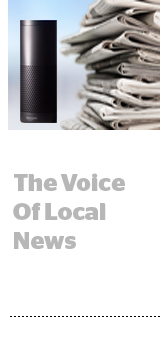
With 21% of US adults owning a smart speaker, according to Edison Research and NPR, publishers have rushed to develop a presence on voice platforms.
“We’re committed to bringing our readers the most compelling journalism on all of the platforms on which they expect us to be,” said Idalmy Carrera-Colucci, senior director of editorial operations at Tribune. “That’s voice now.”
The owner of metro-area dailies including The Chicago Tribune and The Orlando Sentinel began distributing daily news briefings to voice-activated devices back in 2016. In two and a half years, Tribune has developed voice briefings across all nine of its newsrooms.
“Voice just becomes another piece of the morning push to connect with our audience,” Carrera-Colucci said.
McClatchy, another local news powerhouse home to publications like The Sacramento Bee and The Kansas City Star, has launched seven daily news briefings over the past year. McClatchy found that audiences want local coverage that offers breadth over depth when listening to news on voice, as opposed to a podcast, which appeals to a more captive audience.
“A lot of folks listen to these as they get ready for work to get the quick headlines and get on with their day,” said Jon Forsythe, director of editorial video at McClatchy.
But justifying a voice app is challenging for resource-strapped local newsrooms, where production falls to the editorial teams.
“We didn’t have the skill set required to do it really well,” Carrera-Colucci said. “We had to decide, do we want to invest the resources when the audience isn’t large yet?”
Proving value
Using voice platforms like SpokenLayer has made it easier for both Tribune and McClatchy to produce and distribute their voice apps – which enables them to create more content. Tribune, for instance, was able to expand daily briefings to nine of its markets, Carrera-Colucci said.
McClatchy has also inked sponsorships with The Salvation Army and Bose through SpokenLayer’s network of advertisers.
“Bringing national ad dollars to the table is critically important,” Forsythe said. “We’re increasingly seeing interest from brands, which makes our decision to expand easier.”
Publishers also get more detailed analytics on how their briefings are performing through a unified dashboard, making it easier to justify the investment in a nascent space. By the end of the year, McClatchy plans to have daily briefings live in all 30 markets it covers.
“Any time we’re thinking about an expansion, it’s always with that return, reward, risk evaluation in mind,” Carrera-Colucci said. “All newsrooms have had to become disciplined.”
Both Tribune and McClatchy are now focused on growing their voice audiences. McClatchy ran paid digital advertising to raise awareness for its news briefings, but the most successful way to draw audiences was by leveraging its own distribution network, Forsythe said.
“The editors at each our newsrooms wrote a short story to the community saying, ‘We’re now available on the smart speaker, here’s how to listen,’” he said. “It was one of the most effective things we did.”
And Tribune is looking at expanding into new coverage areas, for example lifestyle topics for weekend listeners.
Both publishers are distributing shared learnings across their networks. Tribune, for example, is launching a best practices playbook for its newsrooms that includes tactics around promoting voice briefings through editorial and social media.
Although voice isn’t a major revenue driver yet, both Tribune and McClatchy understand the critical opportunity to reach new audiences and capture shifting consumption habits.
“Is the business model or audience scale, user interface and type of content figured out?” said Will Mayo, CEO of SpokenLayer. “No, but the cost of missing out on that morning habit and intimate relationship newspapers have built on for decades is too high.”
This post was syndicated from Ad Exchanger.


More Stories
oOh!media backs YouthLine ‘Walk the Talk’ fundraiser
Air New Zealand wins March Kantar Ad Impact Award
Tegel gets heads bobbing with dentsu Aotearoa